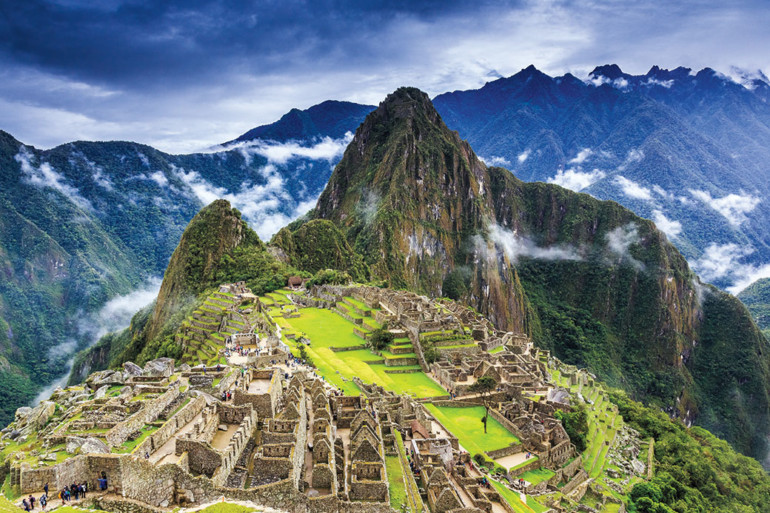IT’S JUST AFTER sunrise as I follow my small group of fellow travelers and our guide up the path to Machu Picchu. And I’m nervous — not the reaction you might expect in one of the world’s most honored and revered places. But the weight of expectation feels intimidating: what if the place I’ve wanted to visit since I first pulled a yellowed copy of Hiram Bingham’s Lost City of the Incas off my parents’ bookshelf has lost its magic, now that it’s visited by more than a million people a year?
But as we round the corner and the mist clears, it’s as if I’ve just stepped into the shoes of the explorers and archaeologists who first pulled apart the jungle vines and stared in wonder and fascination at the massive ruins beneath. It may not be the lost city of the Incas — that’s now known to be Vilcabamba, 50 miles away — and it may not be a place you wander in silent serenity, but it doesn’t matter. The awe is absolute.
Try to describe Machu Picchu, though, and everything that comes to mind sounds like a cliché, has already been said, or both. What you’re left with is a deep sense of mystery and the tingle of a puzzle scholars are still working out.
While most scholars now believe Machu Picchu was built as a palace compound by the Inca emperor Pachacuti, and they agree it was laid out to serve as an astronomical calendar, its full purpose is still unknown. Was it a ceremonial temple, a diplomatic meeting place, a center of craftsmanship or, as has recently been postulated, the final stop in a religious pilgrimage? Why was it abandoned? And how in the world were 50-ton blocks of smoothly chiseled granite carried up the sheer-sided peak and fitted together so intricately that no mortar was needed and a toothpick can’t slide between the blocks?
Exploring its elegantly constructed stairways, plazas and living complexes and marveling at the sophisticated engineering of its terraces, underground waterways and secret passages, I felt my 9-year-old bookworm self come back to life.

My experience in Machu Picchu was as magical as I hoped partly thanks to the efforts of Hotel Sumaq Machu Picchu and its Mystical Tour of Machu Picchu, led by Daniel Gutierrez Vargas, a third-generation shaman. Not only did Daniel introduce us to the philosophy and spiritual symbolism of the Incas, he also conducted a haunting Pachamama ceremony making offerings of fruits, seeds, spices and herbs to the earth goddess — and got us on the first bus in the morning and into the citadel while it was still deserted.
And Daniel’s final thoughts eerily confirmed my sense of childhood awe: “Machu Picchu is a sacred place, and when we feel the energy here, we see it with the heart of a child.”
A piece of advice, here: many people visit Machu Picchu as a day trip from Cusco, and practically speaking, this works. But there are a host of reasons that staying in Machu Picchu Pueblo (formerly Aguas Calientes) for a night — or a few — allows you to have a much deeper and more powerful experience of one of the world’s most famous sights.
One is the chance to hike Mandor Valley and visit Los Jardines de Mandor (Garden of Mandor) with its thundering waterfall and self-guided nature tour of the plants of the Andes along the way. For nerds like me, an extra thrill is knowing that you’re walking along the Urubamba River in the footsteps of Hiram Bingham, seeing the area where he stopped before a local farmer guided him up the mountain to “find” the ruins.
Another is the chance to tour Machu Picchu in the morning, when it’s less crowded before the day-trippers arrive. And being surrounded by Hotel Sumaq’s museum-worthy collection of Inca and Quechua metalwork, weavings and pottery made me feel like I wasn’t leaving Machu Picchu entirely behind when I walked out through the doors.
If, like me, you’ve dreamed since childhood of seeing one of the world’s most iconic sites, why rush the experience of a lifetime?
Cusco: City of Culture and Cuisine
First the capital city of the Inca Empire and then for a time the capital for the Spanish viceroyalty, Cusco is layered with history and culture. Baroque churches tower atop the ruins of Inca temples, and my hotel, the JW Marriott El Convento Cusco, is in the 16th-century Convent of San Agustín, with an Incan burial site in the basement. Look up as you wander Cusco’s steep cobblestone alleys and you’ll see intricately carved wooden balconies and stucco bell towers silhouetted against the sky. Look down and you’ll see Quechua women spreading their multihued weavings along the sidewalks and posing with baby llamas for a photo. A visit to Qorikancha is a literal demonstration of conquest, with the ruins of the Inca Temple of the Sun serving as the foundation for the dominating Santo Domingo Church, and a museum with examples of the goldwork the Spanish looted from the once-dazzling complex. The ruins of Sacsayhuamán, in addition to being some of the most impressive examples of Inca stonework, offer a panoramic view of modern Cusco.

But history is just the beginning; art and food are the pulse of Cusco today. Starting some 10 years ago, Peruvian food seized the global cuisine spotlight, and the Cusco region is arguably the new epicenter of a movement to rediscover and reclaim its indigenous roots. It’s no accident that one of the powerhouses of the movement, chef Virgilio Martínez of Lima’s famed Central, last year sited his new restaurant Mil adjacent to the visually stunning ruins of Moray in the Sacred Valley.
The complex also houses Mater Iniciativa, a groundbreaking research institute founded by Martínez’s sister Malena, which organizes expeditions into the most remote parts of Peru to learn from the indigenous villagers about native herbs, vegetables and other ingredients in danger of being lost to history, environmental degradation and climate change.

In Cusco I also make a pilgrimage to the museum of internationally renowned fiber artist Maximo Laura, where his private collection is on display, glowing with light and color and representing the pinnacle of Peruvian contemporary textile arts. More traditional weaving art is showcased at Central Traditional de Textiles, which houses a gallery and offers guided day trips to nearby villages known for their long history of textile art.

Lima: Colonial Splendor and Artistic Renaissance
Peru’s history, Spanish, Inca and earlier, is rich with mystery, myth, mystique and misinformation, and nowhere is this more on display than in Lima, known as the City of Kings and today a sprawling city of 10 million people.
There is the mystery of Francisco Pizarro’s bones, for example. Enshrined for more than a century in a marble sarcophagus in Lima’s Basilica of San Francisco, they had their authenticity called into question when a box full of old bones was discovered buried below the church. No one knew for sure until 1985, when scholars matched the discovered skull to records of sword cuts from Pizarro’s assassination. And the bones in the original display? They are thought to be those of a scholar, whose name will probably never be known — nor how the switch occurred.
After pondering this, I visit the other many landmarks around Lima’s Plaza Mayor, which include the ornately baroque Archbishop’s Palace, the serene 16th-century Santo Domingo Monastery, and the art deco Gran Hotel Bolívar, which lays claim to having invented the Pisco sour, though several other establishments also take credit for that honor.

More layers of history are on display at Museo Larco, housed in an 18th-century mansion built alongside a seventh-century pyramid. The museum’s astonishing private collection of pre-Columbian art showcases the sculpture, metalwork and pottery of the Mochica, Huari, Chimú and other local indigenous cultures going back 4,000 years, its most popular attraction being a blush-inducing museum of erotic art. Next comes modern Miraflores, where Limeños and visitors flock to bluff-top Parque del Amor (Park of Love) and its enormous statue of entwined lovers, a prized backdrop for selfie-taking couples. While some travelers are discouraged by Lima’s size and notorious traffic congestion, the park’s Gaudi-like mosaic paths and spectacular views of the Pacific aren’t far from my base, the elegant Country Club Hotel, making it possible to linger longer, enjoying the festive vibe.
My favorite part of Lima by far, though, is the bohemian enclave of Barranco, once a seaside getaway for the wealthy, where decaying Beaux Arts mansions now house airy galleries and shops bursting with the best of Peru’s thriving artisan scene. The buildings of Barranco are covered in vibrant murals, so many in fact that the streets are treated as an open-air gallery. In 2015 the government, after causing an outcry when it ordered that some of the older murals be painted over, hosted a contest that drew artists from around the world, so many of the murals are new and the colors dazzling. Don’t miss the gallery of muralist Jonatan “Jade” Rivera, known for his distinctive magical realism, whose work won that contest.

Barranco is also home to several of Lima’s best museums, including the Museo Pedro de Osma, with a private collection of colonial art housed in a columned 19th-century mansion, and MAC, the museum of contemporary art. A must is MATE, the gallery of photographer Mario Testino, which houses his extraordinarily intimate photos of Princess Diana of Wales, the last portraits taken before her death.
I choose a return visit to Barranco for my last night in Lima, walking across the Bridge of Sighs, site of many a romantic tryst, then underneath it down Bajada de los Baños. The steep twisting alleyway, lined with bars and restaurants, leads to a cliff-hugging boardwalk that’s a popular spot to watch one of Lima’s spectacular sunsets. Thinking back on my visit, I remember an oft-repeated quote from the late Anthony Bourdain, who visited Peru for a 2013 episode of his show Parts Unknown. “A prophet once said, ‘Don’t tell me what a man says, don’t tell me what a man knows. Tell me where he’s traveled.’ I wonder about that: do we get smarter, get more enlightenment as we travel? Does travel bring wisdom? I think there is probably no better place to find out than Peru.”
If You Go
It’s important to be aware of new rules governing Machu Picchu that require all visitors to go with a guide and choose one of two halfday time slots, 6 a.m. to noon or noon to 5:30 p.m.
Advice: Stay overnight and go at sunrise, beating the day-trippers from Cusco who arrive for the noon slot. If you hope to hike one of the peaks, Huana Picchu or Machu Picchu itself, you must purchase a permit, and permits often sell out far in advance.
Where to Stay
IN MACHU PICCHU PUEBLO (AGUAS CALIENTES)
Sumaq Machu Picchu Hotel machupicchu hotels-sumaq.com
IN CUSCO
IN LIMA
Where to Eat
IN CUSCO
IN LIMA


